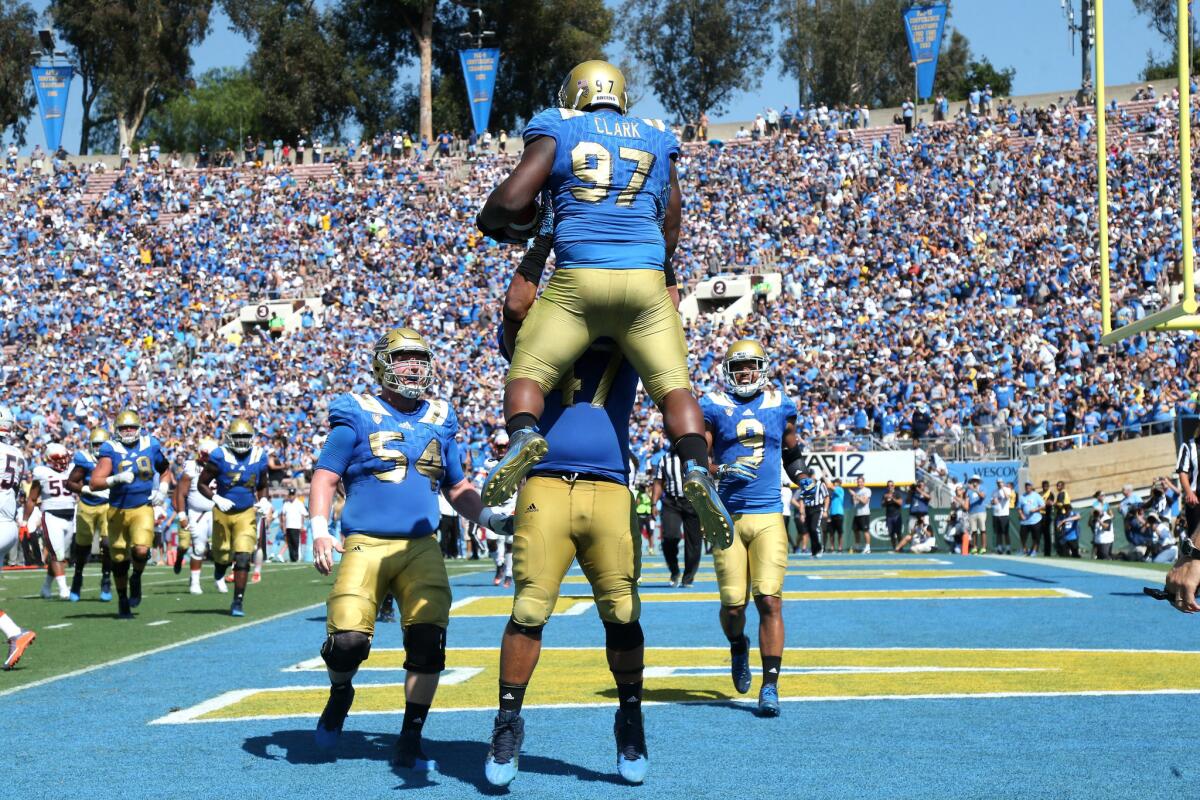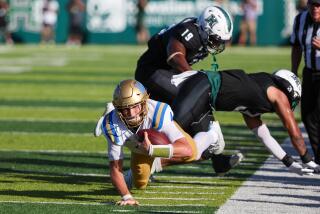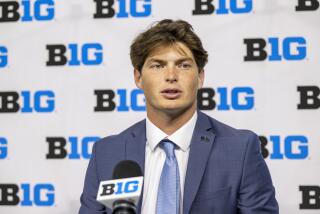Eddie Vanderdoes’ last 2015 moment for UCLA was in celebration

UCLA defensive lineman Eddie Vanderdoes collapsed to the ground after lifting fellow defensive lineman Kenny Clark in the air when Clark caught a three-yard touchdown pass.
- Share via
UCLA Coach Jim Mora and athletic department officials have stressed that Bruins defensive lineman Eddie Vanderdoes did not suffer a season-ending knee injury while celebrating a touchdown.
Mora said Vanderdoes’ knee “locked up on him” a little earlier in the game. But for UCLA fans, the image of Vanderdoes’ last on-field moment this season will be him hoisting 310-pound nose tackle Kenny Clark and collapsing to the turf.
Both had been on offense for a goal-line play. Clark caught a three-yard touchdown pass.
“I was just celebrating with my teammate,” Clark said. “I wasn’t surprised that Eddie did that. We were just playing around.”
Vanderdoes would not be the first player injured in an emotional outburst. He wouldn’t even be the first UCLA player.
UCLA defensive back Sheldon Price suffered a knee injury that kept out nearly a month in 2011. He had jumped, and landed poorly, after nearly intercepting a pass late in a game against Oregon State, on a fourth-down play. The Bruins took over possession with victory assured, but Price hobbled off the field.
“It’s tragic for anyone to be injured like that, with all the work preparation that goes into a season,” said Rick Neuheisel, UCLA’s coach in 2011. But, he said, “no coach wants to strip away any of that emotion. That’s what makes it so fun to play. You don’t want robots out there. You want them jumping in the air in jubilation.”
UCLA baseball Coach John Savage lost one of his best hitters after the Bruins won an NCAA regional in 2010. Infielder Tyler Rahmatulla suffered a broken wrist in the dog pile that came after the Bruins clinched a spot in the College World Series.
“You can’t say ‘don’t dog pile, don’t give high fives,’ ” Savage said. “You can’t prevent players from celebrating a good play or big moment. No coach would ever tell them that. It’s not in the rulebook.”
Savage said that regional victory was a monumental turning point for his program. It was only the second College World Series appearance in UCLA history. The Bruins went to the World Series in 2012 and won the national championship in 2013.
“You start curtailing [celebrations] and you’re getting into a dangerous area,” Savage said. “You’re talking about why they play, why they are teammates, why they are do things together.”
Besides, he said, “it’s unfortunate, but it has happened in the 1970s, the 1980s, the 1990s, the 2000s. It has happened Major League Baseball, the NFL, the NBA.”
A sampler:
In 2013, Georgia receiver Malcolm Mitchell suffered a season-ending knee injury celebrating a teammate’s touchdown.
In 2012, the Angels’ Kendrys Morales broke his leg stomping on home plate after hitting a game-winning grand slam.
In 2001, Tampa Bay kicker Bill Gramatica was lost for the season after injuring his knee jumping to celebrate a field goal … in the first quarter.
And so on.
“You want them, as a team, to congratulate each other,” Neuheisel said. “It’s hard to get to the end zone. That’s why you celebrate.”
More to Read
Go beyond the scoreboard
Get the latest on L.A.'s teams in the daily Sports Report newsletter.
You may occasionally receive promotional content from the Los Angeles Times.







